Will radio kill the internet star?
It was the fall of 1999, and I was in a dormitory room on the top floor of Boston University’s French House - the building where I lived during most of university except during a later summer journalism internship in London in 2001.
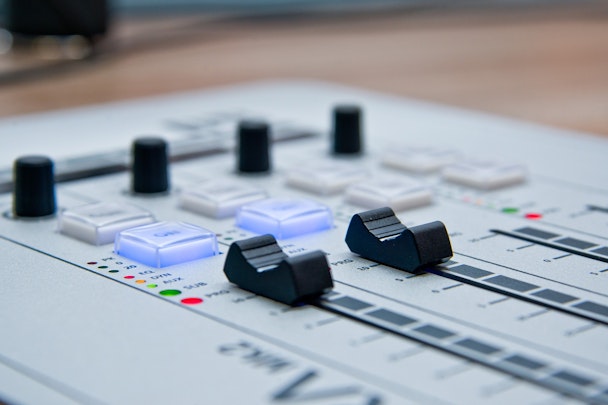
My friend Jeff and I had an exam the following morning in our beach and shoreline processes class, so naturally we were drinking beer, smoking cigarettes, and strumming our guitars to classic rock on 100.7 WZLX the night before.
Long before everyone’s addictions to Facebook and their smartphones - and even since long before the invention of television - people bonded over the radio. That night, WZLX played Stuck in the Middle With You, a wonderful song from 1972 (that would later become synonymous with the film Reservoir Dogs).
Jeff said: “Great Bob Dylan song,” as he raised his beer for a toast.
“What?” I replied. “It’s by Stealers Wheel.”
We argued and could not agree, so we made a bet. We would call the DJ and ask him. The loser would take a shot of something disgusting. I called the DJ, who declared me the winner. Jeff took the shot and gagged, and I shouted in celebration and took a swig of my Natty Ice beer. We and the DJ laughed.
Three minutes later, we heard the whole thing play out live on the radio. We toasted with our beers and started to review why New England beach sand is rocky while Floridian and Caribbean sand is granular. And we left the radio on.
Radio has always been a top medium
Television is nowhere close to being dead. After examining recent data from the US and UK, I have found that radio is still an important medium as well - but with some caveats.
First, take a look at part of Nielsen’s Total Audience Report for the fourth quarter of 2016:
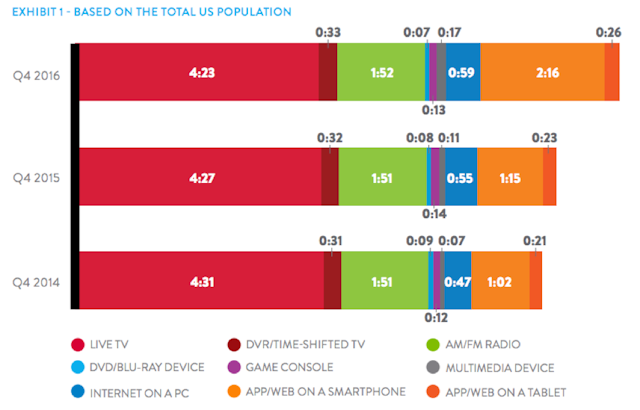
The average person in the US consumes almost two hours of radio every day - and that amount has barely changed
In the UK, the RAJAR Midas Audio Survey for summer 2017 reported these findings:
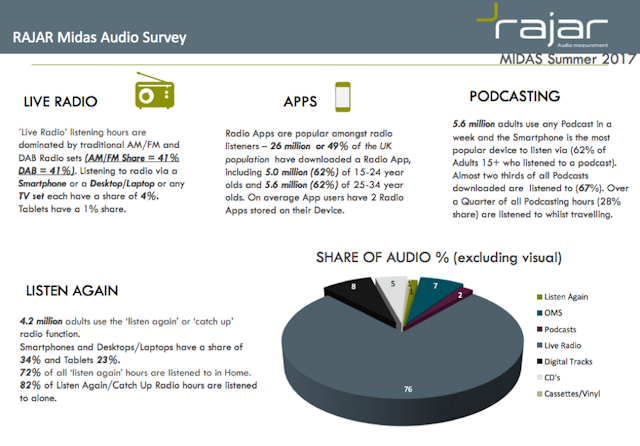
76% of consumed audio programming is live radio on a traditional radio player, television set, smartphone application, or computer.
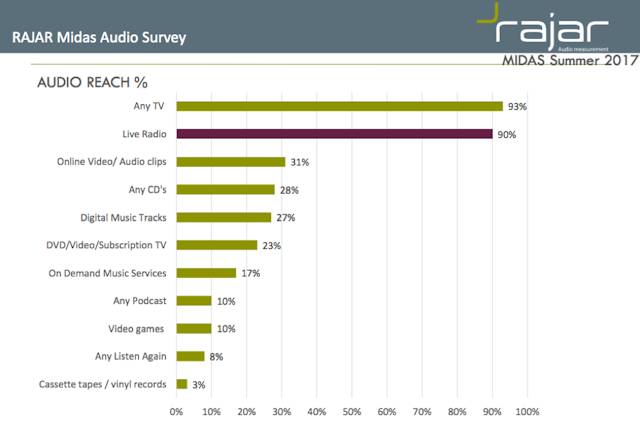
The reach of live radio far exceeds that of newer audio programming models including podcasts and on-demand services such as Spotify.
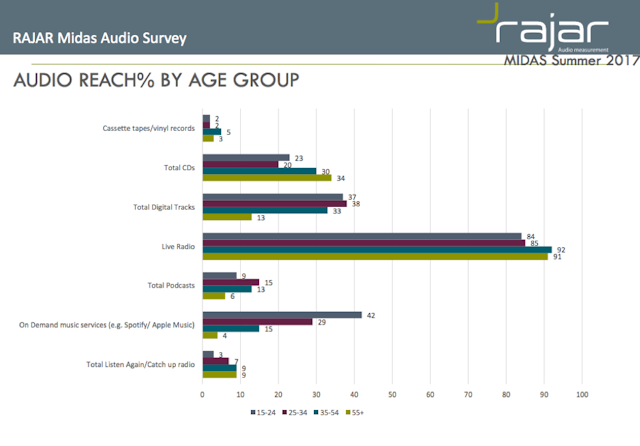
Live radio is the number-one way to reach any age group with audio programming.
What people listen to on the radio
News and talk radio programs have always dominated US radio. But as might not be surprising, Nielsen’s TAR also found that its popularity surged in 2016 likely due to the presidential election and the rise of Donald Trump.
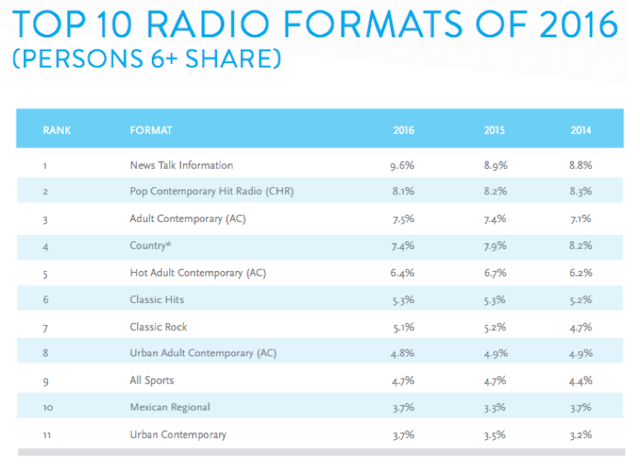
As far as news consumption sources specifically, radio increased its lead over the alternatives.
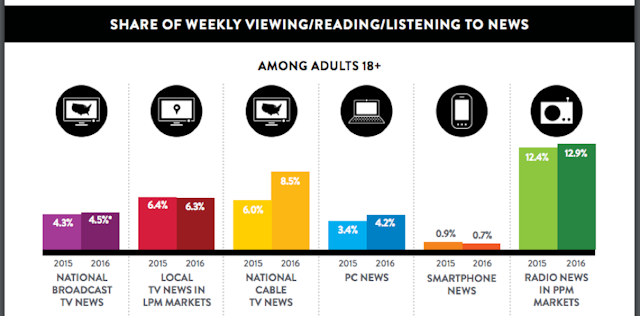
In addition to following current events, another top use for radio is to discover new music. Here is part of Nielsen Music’s Year-End Report for 2016.
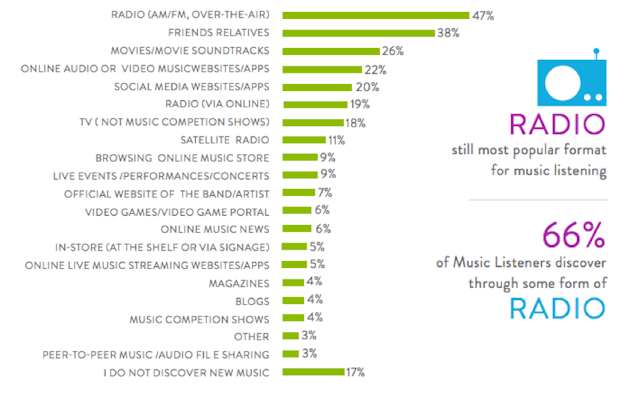
66% discover music over some combination of AM/FM and radio station websites as well as radio broadcast over television, satellites, and mobile apps.
47% of those use regular, old-fashioned AM/FM radio.
How people listen to the radio
These three RAJAR charts piqued my interest.
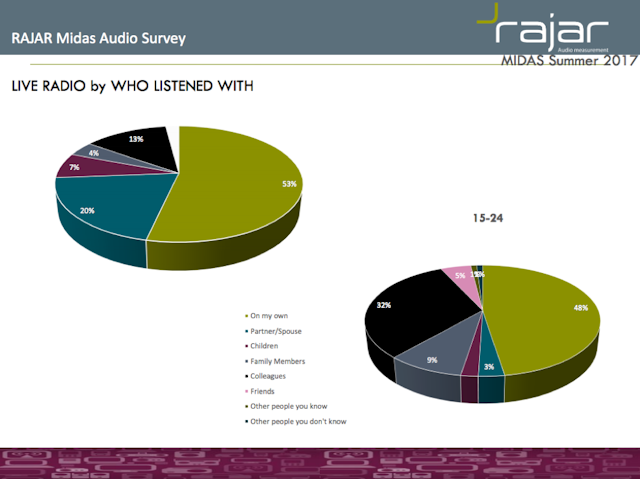
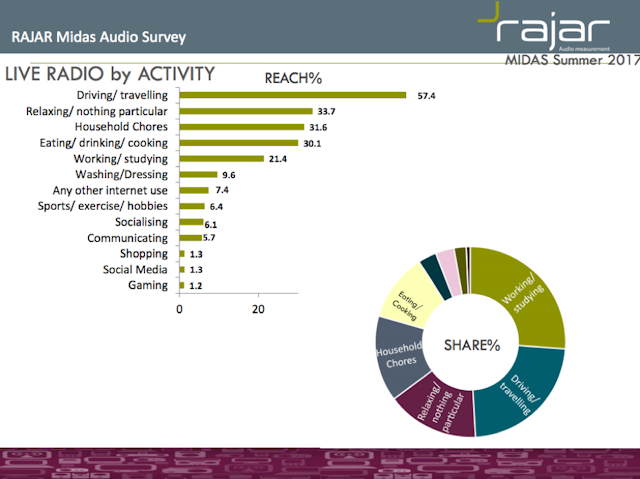
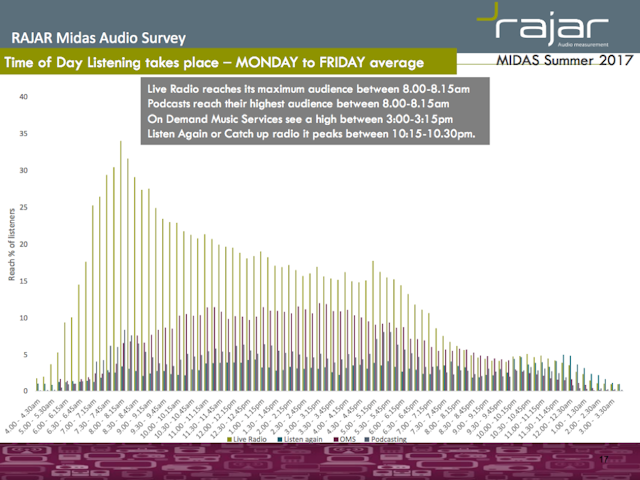
In sum, the typical person in the UK listens to radio and other audio programming alone in the mornings while commuting, getting ready, or doing in particular.
Examples of good radio ads and new tech
Radio is clearly an underrated medium, so many campaigns, partnerships, and technologies have gone unnoticed.
Some great creative work is being done. At this year’s Radio Mercury Awards in the United States, Motel 6 again had the radio ad of the year as well as three best of show campaigns. Deliveroo recently kicked off a multi-channel campaign with 46,000 different audio ads.
Digital radio stations have launched in locations including New York City and Tel Aviv. There are almost four million digital radio listeners in Australia. Google Play Music recently debuted. Canadian adtech company Acurity Ads has partnered with Newcap Radio.
Next Radio, a free mobile app that connects people with local sports, music, and talk FM radio stations, recently released Dial Report, which purports to analyze radio programming in conjunction with census-based listener data to allow brands to do smarter targeting. Dial Report bills itself as the first tool to provide a near-real time view of radio attribution.
Why radio is an important medium
In addition to the reach of radio, the nature of the channel itself is powerful. Many still recognise that fact:
Traditional channels will account for 69% of all global media consumption this year, according to a Zenith Media forecast
BBC, CNN, and Discovery Channel officials have stated that traditional media still has brand power in a supposed digital world
Just like the adoption of the Sony Walkman in the 1980s, millions today are plugged into audio programming for hours every day through earbuds and headphones. I see it every day as people commute or walk around Tel Aviv, and I see it everywhere when I travel throughout the world as a marketing speaker.
Think about the implications. People shut off the world around them and have someone’s voice directly entering their ears and brains. That is influential. Radio is about as intimate as you can get with another person on a bus without getting arrested. Even if people are listening to the radio in the background as they study, cook, or do housework, their minds are still receiving the messages.
Now, compare radio’s influence to that of digital mediums. According to the PPC software and services agency WordStream, Google AdWords advertisements have an overall click-through rate of 2% in search results. The agency’s accompanying studies show that the best corresponding rates for Facebook do not even reach 2%.
Most digital ads are completely ignored, and that doesn't even take into account the online advertising fraud and ad blocking scripts that prevent ads from appearing in front of human beings in the first place.
Radio’s metrics are audited and more reliable than adtech. Despacito is reported to be the new most-watched YouTube video with more than 3b views, but we do not know how many of those views are bots or otherwise generated by click farms. We do not know how many viewers dropped off after a few seconds.
Not all impressions are created equal. We will have a better idea when we have one unified metric - such as average viewers or listeners per minute - across all traditional and digital channels. For now, the reach figures for television and radio are much more authentic.
“Digital ads are recording fraudulent airplay, being misplaced on inappropriate websites, or being ignored completely by consumers,” Zamir Ahmed, director of media relations for the National Association of Broadcasters in the United States, told me in an e-mail interview. “Companies are finally taking a stand against waste, fraud, and abuse in the digital advertising space.
“With radio, advertisers are getting a known quantity,” he continued. “They know their ads are going to get airtime and how many people will be tuning in. Their ads won’t be appearing with inappropriate content. Advertisers will have a relationship with a radio sales representative who will work with them on an ad campaign that will work for them.”
Advocates of radio’s benefits to mass media marketers generally point toward its affordability, reach, and trustworthiness.
“Radio is second only to TV in terms of ROI,” Lucy Barrett, client director for the UK trade body Radiocentre, told me in an e-mail that referenced radio’s recent record-breaking ad sales last year. “In the UK, advertisers get an average of £7.70 for every pound they spend in radio.”
“This data is also backed up by independent analysis by our friends over at Thinkbox, which also shows radio as the second best ROI,” she continued. “The good news for radio advertisers is that radio is significantly cheaper than advertising on TV, but we also work very well with TV so it is a great way for marketers to make their budgets stretch that bit further.”
What about millennials?
Still, the signal of radio’s future is not clear. Look at this analysis of Nielsen RADAR December 2016 data by the Radio Advertising Bureau in the United States:
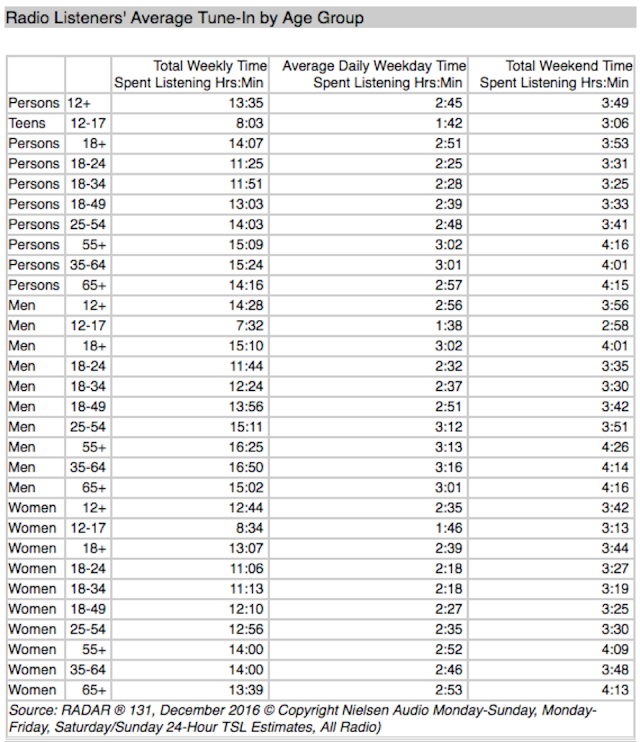
If you look at the fifth row, you’ll see that even 18-34 year olds in the United States listen on average to almost twelve hours of broadcast radio per week. The second row of 12-17 year olds listens to eight hours per week. Now, compare those numbers to the older demographic segments.
In the UK, the Institute of Practitioners in Advertising used its TouchPoints platform to run a demographic analysis in response to a request of mine. The results found the following in terms of the average number of hours of radio listening per day.

Despite the advantages of radio, the biggest risk is that younger people might tune out over time. The decline in average daily listening time fell from 2008 to 2016 by 30% for millennials (18-34) and 54% for teenagers aged 15 to 17.
Clearly, this is an issue that needs attention. Younger people seem not to like radio as much as my friend Jeff and I did in university. But Next Radio President Paul Brenner told me in an e-mail interview that he is not worried.
“One of our top two biggest listening audiences in the Next Radio app is the 18-24 age group,” he wrote. “This target group is coming to radio to discover new music, connect to their community, and turning to radio as a trusted source for the latest news. Radio reaches an impressive 91% of all Americans age 12 or older every week. Listeners continue to turn to radio for news, information and entertainment - despite an ever-increasing selection of media options.”
It is generally bad to target a demographic segment, instead it is best to target a cross-generational market segment - and that specific group of people may or may not listen to radio. What a group of 75 million people think about radio is usually irrelevant to any given marketing campaign.
But for those readers who are still obsessed with millennials, Nielsen also found that those younger listeners are the ones driving the aforementioned trend of people increasingly turning to radio for news.
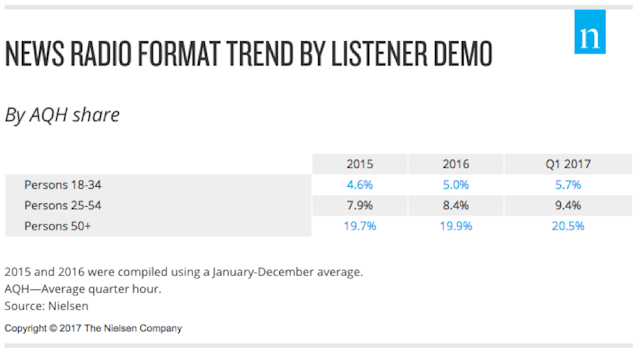
The future of radio
It’s time to fix the promotion mix by remembering that video did not kill the radio star, the Internet did not kill the television star, and radio will not come back to kill the the Internet star. The Internet is merely an additional set of new channels over which audio and visual media can be transmitted in Marcom campaigns.
Every medium has a potential use. Sometimes TV and radio will be good choices; sometimes not. Sometimes social media can be useful; sometimes not. The key is to create an integrated plan of marketing tactics and channels without bias based on the market research and orientation as well as the overall strategic goal. One good resource is this new guide from Byron Sharp’s Ehrenberg-Bass Institute that was published by the University of South Australia.
Many marketers routinely proclaim that one thing or another is dead. Do not believe them and look at the data instead because most of the time, they are selling something. Just see what BBC World Affairs editor John Simpson recently tweeted: "On my first day at BBC in 1966 someone advised me to get out of radio because it was dying. Latest figures: Radio 4 gets 11.55m listeners a week."
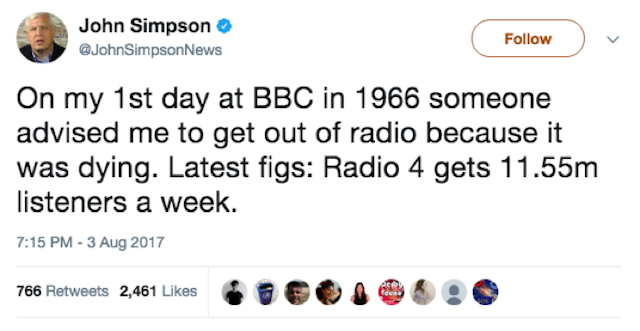
The effect of radio
The famed American broadcaster Edward R. Murrow dramatised Britain’s resilience against Adolf Hitler during the blitz over the radio and helped to rally the United States to enter World War II. On the morning of September 11 2001, I listened to the news on the radio and fought back tears as I drove a van filled with furniture through downtown traffic jams to move into Boston University for my senior year.
Radio is humanity - and that humanity is being transmitted today through an increasing number of online and offline pipes. Even if the effect on sales is not always as trackable as in direct-response campaigns, radio is still often an influential touchpoint in brand advertising campaigns.
The Promotion Fix is an exclusive biweekly column for The Drum contributed by Samuel Scott. Follow him on Twitter and Facebook.

